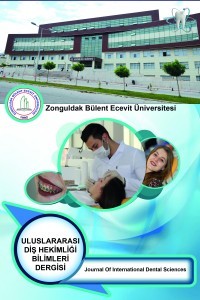FARKLI TUTUCU SİSTEMLERİNE SAHİP İMPLANT DESTEKLİ PARMAK PROTEZLERİ: 4 OLGU SUNUMU
Konjenital veya travmaya bağlı parmak kaybında cerrahi tedavinin başarısız olduğu veya kontrendike olduğu vakalar parmak protezleri ile tedavi edilebilmektedir. Parmak protezleri geride kalan parmak dokusunun yeterli olduğu durumlarda kemik içine yerleştirilen implantlardan destek alabilmektedir. İmplant destekli protezler hastaya estetik ve psikolojik desteğin yanında kavrama fonksiyonu ve bir miktar dokunma hissi de kazandırmaktadır. Protezlerin implant dayanağına bağlanması sırasında kullanılabilecek çeşitli tutucu sistemleri bulunmaktadır. Bu olgu sunumu, implant destekli parmak protezlerinde kullanılabilecek 4 farklı tutucu sistemini incelemeyi amaçlamaktadır. Protezlere retansiyon sağlamak için döküm metal teleskobik tutucu, zirkonya teleskobik tutucu, hassas tutucu ve manyetik tutuculu silikon protezler hazırlanmıştır. Kontrol seanslarında implantlar stabil ve kemik doku normal trabeküler yapıda gözlenmiştir. Hastalar estetik olarak memnun kalmışlardır. En uygun tutucu tipinin hangisi olduğu konusunda fikir birliği bulunmamaktadır ancak bu olgu sunumunda anlatılan tüm tutucu tiplerinde gerekli retansiyon sağlanmıştır. İmplant destekli parmak protezleri, estetik ve fonksiyon sağlamak amacıyla ampute parmaklarda iyi bir tedavi seçeneğidir.
Anahtar Kelimeler:
Ampütasyon, dental implant, silikon, hassas tutucu, zirkonyum
IMPLANT-RETAINED FINGER PROSTHESES WITH DIFFERENT ATTACHMENT SYSTEMS: REPORT of 4 CASES
The loss of fingers due to congenital deficiencies can be treated with a finger prostheses where surgical treatments failed or contraindicated. Finger prostheses can be supported by implants placed into bone where the stump is sufficient. Implant-retained finger prostheses provide some tactile sensation and grasping ability to the patient in addition to the aesthetic and psychological support. There are several attachment systems that can be used to unit the prostheses and implants. Aim of this study is to evaluate the 4 different attachment systems used in implant retained finger prosthesis. Implants were placed into residual bone structures using two-stage surgical procedure. After osseointegration of implants, impressions of implants and stumps were taken. Four different attachments including magnetic attachment, metal telescopic attachment, zirconia telescopic attachment, and dental precision attachment were applied to patients for retention of prosthesis. Silicone prostheses were fabricated and delivered to the patients. Treatment outcomes of different attachment types were observed during patient recalls. The implants are stable in follow-up appointment and the bone tissue has normal trabecular structure. Patients were esthetically satisfied. The adequate retention is provided in all attachment types. While telescopic and precision attachments have more retention, magnetic attachments provide ease of use. Advantages of implant-retained finger prostheses including restoration of the natural appearance of the hand and providing some tactile sensation are well known. The choice of the optimal attachment for the finger prosthesis is not clear. Reconstruction of fingers with implant-supported prosthesis is a viable option for amputed fingers by providing aesthetic and functional improvements.
Keywords:
Amputation, dental implant, silicone, denture precision attachment, zirconium,
___
- 1. Kuret, Z, Burger, H, Vidmar, G, Maver, T. Adjustment to finger amputation and silicone finger prosthesis use. Disabil Rehabil 2019; 41(11): 1307-1312.
- 2. Grob, M, Papadopulos, N, Zimmermann, A, Biemer, E, Kovacs, L. The psychological impact of severe hand injury. J Hand Surg Am (European Volume) 2008; 33(3): 358-362.
- 3. Heitmann, C, Levin, LS. Alternatives to thumb replantation. Plast Reconstr Surg 2002; 110(6): 1492-1503.
- 4. Dewan, S, Kalra, T, Kumar, M, Bansal, A. Prosthetic Rehabilitation of Amputated Fingers Using Thimble Prosthesis: A Novel Methodology. Dent J Adv Stud 2019; 7(03): 131-134.
- 5. Arzu, A, Gürbüz, DCC, Günay, Y. Adeziv Yapıştırıcı ile Kullanılan Parmak Protezi: Olgu Sunumu. Atatürk Üniv Dişhek Fak Derg; 23: 44-47.
- 6. Lundborg, G, Waites, A, Björkman, A, Rosén, B, Larsson, E-M. Functional magnetic resonance imaging shows cortical activation on sensory stimulation of an osseointegrated prosthetic thumb. Scand J Plast Recons 2006; 40(4): 234-239.
- 7. Amornvit, P, Rokaya, D, Sanohkan, S. Applications of PEEK in implant retained finger prosthesis. J int dent 2019; 12(4): 1606-1609.
- 8. Aydin, C, Karakoca, S, Yilmaz, H. Implant-retained digital prostheses with custom-designed attachments: a clinical report. J Prosthet Dent 2007; 97(4): 191-195.
- 9. Doppen, P, Solomons, M, Kritzinger, S. Osseointegrated finger prostheses. J Hand Surg Am (European Volume) 2009; 34(1): 29-34.
- 10. Sierakowski, A, Watts, C, Thomas, K, Elliot, D. Long-term outcomes of osseointegrated digital prostheses for proximal amputations. J Hand Surg Am (European Volume) 2011; 36(2): 116-125.
- 11. Misch, C. Mandibular and Maxillary Implant Overdenture Design and Fabrication. Dental Implant Prosthetics. Second Edition ed. St. Louis, Missouri: Mosby, Elsevier; 2014. 805-807.
- 12. Holgers, K, Tjellström, A, Bjursten, LM, Erlandsson, B. Soft tissue reactions around percutaneous implants: a clinical study on skin-penetrating titanium implants used for bone-anchored auricular prostheses. Int J Oral Maxillofac Implants 1987; 2(1): 35-39.
- 13. Goiato, MC, Garcia‐Júnior, IR, Magro‐Filho, O, Dos Santos, DM, Pellizzer, EP. Implant‐retained thumb prosthesis with anti‐rotational attachment for a geriatric patient. Gerodontology 2010; 27(3): 243-247.
- ISSN: 2149-8628
- Yayın Aralığı: Yılda 3 Sayı
- Yayıncı: Zonguldak Bülent Ecevit Üniversitesi
Sayıdaki Diğer Makaleler
Endodonti-Ortodonti Arayüzü: Endodontik Tedavi, Ortodontik Kuvvet ve Dental Pulpa İlişkisi
Büşra DEMİR ÇİÇEK, Orhan ÇİÇEK
65 yaş ve üstü hastaların sistemik durumlarının değerlendirilmesi
A.pinar SUMER, Mahmut SÜMER, Mesude ÇİTİR, F.zehra BODUR, Günay GÜRAY, Soner ÇANKAYA
ÖN ISITMA İŞLEMİNİN SÜT DİŞİ KÖK KANAL PATININ AKIŞKANLIĞI ÜZERİNE ETKİSİ
Ebru HAZAR BODRUMLU, Seda Nur DEMİR
FARKLI TUTUCU SİSTEMLERİNE SAHİP İMPLANT DESTEKLİ PARMAK PROTEZLERİ: 4 OLGU SUNUMU
Seçil KARAKOCA NEMLİ, Bilge TURHAN BAL, Merve BANKOĞLU GÜNGÖR, Ceyda Başak İNAL
Fatih EROL, Ecehan HAZAR, Murat KOCAK, Sibel TAZEGÜL-KOCAK, Baran Can SAĞLAM
TAM DİŞSİZLİĞİN MODİFİYE HİBRİT PROTEZLER İLE RESTORASYONU: OLGU SUNUMU
